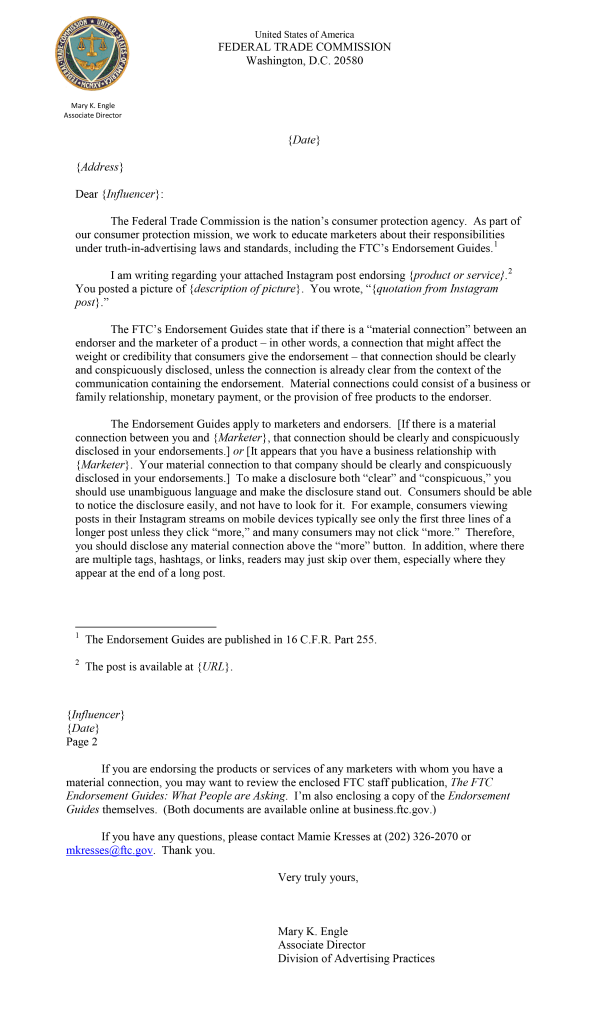Table of Contents
What Are Influencer Marketing Laws?
As with any marketing strategy, legal and ethical issues come into play. In regard to influencer marketing, the biggest concerns revolve around transparency and disclosure. This means that consumers most know all of your marketing efforts are the result of a partnership between the company and the influencer.
When thinking about how impactful social media can be, it can seem unfair or misleading when consumers don’t know that a certain post or page exists because an influencer got money or free products for it. That is why the U.S. Federal Trade Commission (FTC) created Endorsement Guidelines that explain key influencer marketing guidelines and examples for companies to use.
In April 2017, the FTC sent 90 letters to influencers and marketers to educate them on these influencer marketing laws. The letters explained that brands and influencers must clearly disclaim when a personal relationship between the two exists and influences the promotion. The relationship must also be disclosed if money or free products were exchanged for the promotion.
In September 2017, 21 warning letters were sent out to individuals from the original 90 whose disclosures were not meeting the FTC’s standards. Celebrities such as Lindsay Lohan, Naomi Campbell, and Sofia Vergara were among some of the 21 recipients. According to the FTC, if it gets to the point of sending a final order, those found guilty can face a civil penalty of up to $40,654. It has been made clear that the FTC is willing to crack down on violators of influencer marketing laws, making it more imperative than ever to be aware of what they are and how to follow them.
How to Follow Influencer Marketing Laws
How can you make sure you are following these influencer marketing laws? It can be tricky, mainly because there are no set-in-stone rules to follow. The whole process is more of a common-sense idea that requires every promotion to clearly state that it is a promotion.
You’ve probably seen tons of these disclosures on platforms like Instagram where influencers leave #ad, #paid, or #sponsored in their captions. That is the easiest way to ask your influencers to disclose. (Pro tip: The FTC has already shut down shortcut hashtags like #sp, #partner, #abassador, or #thanks[brand name], for not being clear enough so don’t try them!)
Some platforms have disclosure options already built into them that you can consider using too. Recently, Instagram added the branded content option for business and influencer accounts. This option automatically pops up when the caption includes typical disclosure messages such as #ad, and asks if the post is in partnership with a brand. The influencer can choose yes, and the post will automatically state that the post is a paid partnership where the location tag typically shows up. This feature is expected to be mandatory in the future, so practice using it now! (However, don’t rely on these features to be enough, rather use them in conjunction with other disclosure methods discussed later in this article.)
When to Disclose:
So when is it necessary to disclose information? The simple answer is that influencers should disclose whenever there is a relationship between them and the brand, which is known as a “material connection.” This means anytime your brand works with an influencer, whether you exchange money, products, or any other rewards/discounts for the post, your influencer should tell their audience. Even if the brand doesn’t specifically ask for products to be mentioned, it’s always a good idea for the influencer to disclose that some sort of professional or personal relationship is there.
For instance, if you own a business and happen to be personal friends with an influencer, they could shout you out simply to be a good friend, but their audience may feel a little misled if they later find out you two are friends, a relationship that could make the recommendation or post less genuine. However, if it is made clear from the beginning that you two are friendly, the audience will have all the information to decide for themselves whether the promotion is fair or not.
How to Disclose:
Like we mentioned before, there are no hard laws to disclosing, but hashtags such as #ad, or #sponsored are always a good idea. But what if you are sponsoring content on platforms other than Instagram? A good general rule is to have the disclosure on the content itself (such as right on a graphic or screen as opposed to an “About” page or somewhere the viewer has to click to access like a “See More” button.) On platforms where the content moves like Snapchat or Instagram stories, the disclosure should be placed on top of the picture or video, somewhere where it is clearly visible to the viewer. It should never be questionable whether something is sponsored or not.
Your relationship with your influencer may look something like this:
- You (the brand) reach out to an influencer about working together/sending them products/etc.
- They agree to work with you.
- You send them a contract or written statement clearly laying out what posts are expected of them, when, and about what. Here you can clearly lay out the disclosure methods you expect them to use (whether it is a certain hashtag or in-app tool.) NeoReach has an example of influencer terms and conditions you may want to check out.
- The influencer agrees to the terms and conditions and sends you a draft of their post.
- The brand reviews the post, making sure disclosure is clear and present.
- The influencer posts the approved content.
- The brand double-checks that all content posted matches the approved draft.
Some things to keep in mind:
- Each brand is responsible for what its influencers say. Make sure your influencers know the rules and monitor their posts to make sure they are adequately disclosing.
- Place your disclosure so it’s hard to miss.
- Don’t mix disclosures into large groups of hashtags or links.
- If the content is in the form of the video, the disclosure should be in the video, not just in the description.
- If the content is in the form of a live stream, the disclosure should be repeated periodically.
Keep It Ethical:
Remember, when asking influencers to endorse your brands or products, the reviews and promotions need to remain authentic.
- Influencers can’t talk about their experience with products they haven’t tried.
- If an influencer is paid to promote a product they thought was terrible, they can’t say it was great.
- If an influencer is going to make claims about a product, the brand must be able to back it up with research/scientific proof that the claims are accurate.
If influencers are lying about your products, chances are their viewers will catch on thus making the influencer and the brand look bad!
Updated Guidelines:
Recently, the FTC released updated guidelines, including a brochure and even a video to help explain when and how to disclose. The new guidelines discuss things such as:
- How does the disclosure requirement apply in pictures, videos, and live streams?
- What about tags, likes, and pins?
- What kind of wording effectively discloses a material connection?
- What about influencers who post from outside the United States?
- What if a person doesn’t have a relationship with a brand, but is just telling others about a product they bought and happen to like?
- Is it okay to assume a platform’s disclosure tool is good enough?
You can check out this article for even more tips on how to disclose according to the newest guidelines. The FTC also has a great database dedicated to influencer marketing guidelines. If you want NeoReach to worry about influencer marketing laws for you, check out our pricing or chat with us!
This is not legal advice nor should it be considered legal advice. Always seek professional legal advice from your licensed attorney.



























